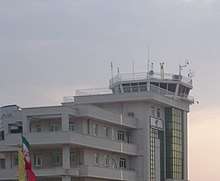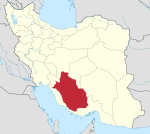Lar, Iran
Lar (Persian: لار, also Romanized as Lār; also known as Larestan)[2] is a city and capital of Larestan County, Fars Province, Iran. At the 2006 census, its population was 55,265, in 6,891 families.[3] Lar's inhabitants are Larestani people.
Lar لار | |
|---|---|
City | |
 | |
 Lar | |
| Coordinates: 27°40′52″N 54°20′25″E | |
| Country | |
| Province | Fars |
| County | Larestan |
| Bakhsh | Central |
| Area | |
| • Total | 5,000 km2 (2,000 sq mi) |
| Elevation | 802 m (2,631 ft) |
| Population (2016 Census) | |
| • Total | 62,045 [1] |
| Time zone | UTC+3:30 (IRST) |
| • Summer (DST) | UTC+4:30 (IRDT) |
| Area code(s) | 0715 |
History
The city was originally called Lar after the person who had first established the city. Lar (لاڑ) is the name of one of Shahnameh's famous heroes. Around 16th and 17th centuries, Lar was considered to be a major stop along the road to the Persian Gulf.
Larestani people migrated to Arab states in the Persian Gulf in significant figures around the 1600s, such as Qatar, the UAE, Bahrain, and Kuwait. Some have surname as "Lari" or "Al Lari" along with many other family and tribal names.
Climate
| Climate data for Lar | |||||||||||||
|---|---|---|---|---|---|---|---|---|---|---|---|---|---|
| Month | Jan | Feb | Mar | Apr | May | Jun | Jul | Aug | Sep | Oct | Nov | Dec | Year |
| Average high °C (°F) | 18.3 (64.9) |
19.3 (66.7) |
23.5 (74.3) |
26.8 (80.2) |
32.4 (90.3) |
35.3 (95.5) |
36.5 (97.7) |
35.9 (96.6) |
34.1 (93.4) |
31.2 (88.2) |
25.1 (77.2) |
20.3 (68.5) |
28.2 (82.8) |
| Daily mean °C (°F) | 12.4 (54.3) |
13.7 (56.7) |
17.4 (63.3) |
20.7 (69.3) |
25.6 (78.1) |
28.6 (83.5) |
30.5 (86.9) |
30.1 (86.2) |
27.8 (82.0) |
24.6 (76.3) |
18.6 (65.5) |
14.2 (57.6) |
22.0 (71.6) |
| Average low °C (°F) | 6.6 (43.9) |
8.1 (46.6) |
11.4 (52.5) |
14.6 (58.3) |
18.9 (66.0) |
21.9 (71.4) |
24.6 (76.3) |
24.3 (75.7) |
21.5 (70.7) |
18.0 (64.4) |
12.1 (53.8) |
8.2 (46.8) |
15.9 (60.5) |
| Average precipitation mm (inches) | 45 (1.8) |
47 (1.9) |
13 (0.5) |
15 (0.6) |
0 (0) |
0 (0) |
1 (0.0) |
1 (0.0) |
0 (0) |
2 (0.1) |
14 (0.6) |
35 (1.4) |
173 (6.9) |
| Source: Climate-data.org | |||||||||||||
Larestani Language
The outstanding specification of Larestan county, is the people's dialect. The vocabulary of the Larestani language(Achomi or Ajami) dialect holds many words in common with Persian, however the syntax is considerably different from the current Persian language. Some believe that the Achomee dialect is in fact derived from an older dialect that survived through the impact of Arabic on old Persian language.
Achomee language is derived from the medieval Iranian language Pahlavi, the language of Sassanid Persia, which is also a precursor to Modern Persian and all other existing dialects included in the southwest branch of the Iranian language group.
The name Pahlavi was applied to a number of different dialects spoken in a rather vast area from Ctesiphon in modern-day Iraq to the southern coast of the Persian Gulf. The area corresponds to the greater Pars province.
The term 'Pahlavi,' in its widest extent, is applied to all the varying forms of the medieval Persian language, from the time when the grammatical inflexions of ancient Persian were dropped, till the period when the modern alphabet was invented, and the language became corrupted into modern Persian by the adoption of numerous Arabic words and phrases.]
Achomee language retains many words from Pahlavi and grammatical peculiarities that distinguish it from her sister Modern Persian. There is considerably less Arabic influence in the diction of Lari than there is in Modern Persian, suggesting that Achomee descends from a purer Iranian tongue. Arabic words have mostly been imported indirectly by the influence of Modern Persian. But Lari People do still speak the Arabic language due to the Arabic culture they carry.
Some grammatical properties of Achomee are also found in other Iranian language such as Kurdi/Luri and also in more distanced related languages, such as Gilaki and Kurdish, both of which are included in the northwest branch of Iranian Languages.
Another important feature of Achomee is that it has kept stronger ties to its grandmother old Persian compared to ties between old and modern Persian. That is perhaps due to the fact that being a local language there is less need to be dynamic, less need for development and less need for interaction towards other local languages. Achomee is an oral language and it has no much literature. The written and official language has always been modern Persian.
Civilization
Lar city is divided into two areas: new-city (called Shahre-jadid) and old-city (called Shahre-ghadim). New-city, which was constructed after the historical earthquake of 1960, now accommodates the main population and is considered to be modern in terms of civil and transport engineering (e.g. dead-ends are very rare). The Old city contains the Bazaar of Qaisariye, a pre-Safavid dynasty creation, that was proposed as a UNESCO World Heritage Site on August 9, 2007.[4]
Transport
As the Department of Roads & transport & some other centres are situated in city of Lar, an interesting aspect of it is building & construction of a modern expressway between the city of Lar and a police station 10 km from the city of Gerash, but in the cost of cutting most spending from other town & villages' roads in the region & it costs human life in the road accidents in the regions which happens almost daily & have high fatality rates. The 6-lane expressway has been fully upgraded with high luminous lighting and high quality pavement to facilitate the transportation needs of people of Lar town but the cost is paid by cutting almost all other funds for repairs & making new roads in the area who are governed by Lar Road & Transport Department in Lar.[5]
Lar has an airport with daily flights to domestic and international destinations including Tehran, Dubai, Kuwait, Doha, Sharjah, etc.
Gallery
References
- https://www.amar.org.ir/english
- Lar, Iran can be found at GEOnet Names Server, at this link, by opening the Advanced Search box, entering "-3072906" in the "Unique Feature Id" form, and clicking on "Search Database".
- "Census of the Islamic Republic of Iran, 1385 (2006)". Islamic Republic of Iran. Archived from the original (Excel) on 2011-11-11.
- Bazaar of Qaisariye in Laar - UNESCO World Heritage Centre
-
https://web.archive.org/web/20070103220349/http://www.larroad.ir/roads.asp. Archived from the original on January 3, 2007. Retrieved October 25, 2006. Missing or empty
|title=(help)
External links
| Wikimedia Commons has media related to Lar. |
- Gerash - Information on history, demographics and photos of this region
- Khodmooni Forum Connecting Khodmoonis All Over the World
- Emaddeh information Up to date information about Emaddeh & Other Achmoi areas, news, photos, etc.
- . New International Encyclopedia. 1905.


